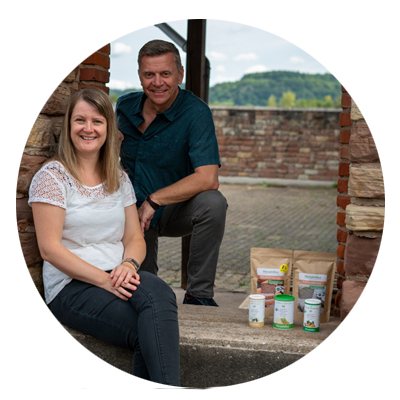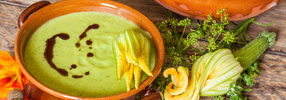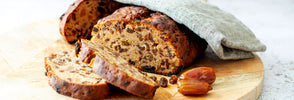
Which histamine type are you? Part 1
Histamine intolerance is always very individual and is based on different causes. Depending on the individual cause, certain histamine types can be derived. We want you 8 different histamine types introduce. Maybe you recognize yourself in one or the other type. Of course there are also mixed types and one type can also go into the other if the actual cause remains untreated.
Today we start with the first 4 types. Which type are you?
The bacterial type
Our intestinal flora is inhabited by trillion intestinal bacteria. These small microorganisms help you digestion and at the same time prevent harmful germs, degradation products or undigested particles through the intestinal mucosa. So man lives in a symbiosis with the intestinal bacteria. We provide the bacteria with food and they pass harmful intruders. All of these bacteria live in our DAM in an individual balance. However, if there is an imbalance, a dysbiosis can arise: i.e. harmful bacteria multiply strongly, while the useful bacteria are increasingly reducing. Due to the outnumber of the harmful bacteria, there is now an increased histamine formation and putrefaction processes. The bacteria type thus suffers from a dysbiosis caused by an excess of histamine -forming bacteria. (1)
Histamine artists are in particular the putrefaction bacteria:
- Hafnia
- Clever
- Morganellen
- Serratia
These putrefaction bacteria form the biogenic amin histamine from the amino acid Histidine. The DAO (histamine -reducing enzyme) is also formed in our intestinal mucosa. Dysbiosis can lead to the DAO is no longer sufficiently formed or that it is overwhelmed due to the increased histamine level.
Symptoms:
- Flatulence
- Bump off
- Foul
- Digestion disorders (diarrhea, constipation)
- Intestinal cramps
- Again and again gastrointestinal symptoms despite low-histamine nutrition
- Fewer and fewer foods are tolerated
The following laboratory values make sense:
- Histamine levels in the intestine
- Creation of an intestinal profile (Candida, parasites, leaky good, inflammation, composition intestinal bacteria)
- Have other bowel diseases clarified (Sibo, Leaky Gut, including)
- Clarify further food intolerances and allergies
- Vitamin and mineral status (especially co-factors of the DAO)
Therapy approaches:
- Structure of the intestinal flora
- Taking probiotics (e.g. The bacteria sensitive)
- Colon renovation (depending on the intestinal found mushroom diet, parasite curgeon)
- Treat leaky well
- Low -histamine, low -inflammatory diet
- Avoid pleasure toxins (sugar, alcohol, caffeine)
- Fill out a shortage of micronutrients
The mast cell type (2)
Histamine is not only absorbed through food, but also formed in our body in the mast cells. The messenger substance histamine belongs to our immune system and ensures an inflammatory reaction in the body when intruders or pathogens arrive. Certain foods or external factors (such as heat, cold, skin products, etc.) can also trigger the mast cells to release histamine. The mast cell type therefore suffers from symptoms caused by too much histamine from the mast cells due to the distribution. This also includes mast cell activation diseases such as the MCAS.
Frequent pathogens can be e.g.
- Helicobacter pylori
- Clostridia difficile
- Campylobacter
- Enterobacter
- Candida (mushrooms)
- Parasites
- Virus
Chronic inflammatory bowel diseases such as Crohn's disease or ulcerative colitis, food allergies, small intestinal misalignment, leaky goods, certain medication, chronic stress and alcohol consumption can also be associated with increased histamine levels. In the case of chronic inflammatory bowel diseases, the histamine-reducing enzyme DAO can affect. It is limited in its activity and number. Chronic inflammatory bowel diseases can also create other intolerances such as lactose, gluten or fructose.
Symptoms:
- Gastrointestinal complaints and diseases (see above)
- Bloating, constipation, intestinal cramps
- Weakening of the immune system
- Food intolerances, food allergies
- Tinnitus
- Rashes, itching, wholesale formation
- Mood fluctuations, fears, exhaustion
- Various seeing, itchy eyes
- Irritated mucous membranes
- V.M.
Laboratory values:
- Have the above pathogens clarify
- Clarify chronic inflammatory bowel diseases
- Darmal profile (Candida, parasites, leaky good, inflammation, composition intestinal bacteria)
- Clarify mcas and mastocytosis
- Vitamin and mineral status
Therapy approaches:
- Depending on the pathogen individually with the therapist
- Depending on the finding - treat other diseases
- Colon renovation, fungi diet, parasite curgeon
- Pay attention to histamine triggering foods when eating
- Avoid histamine -triggering external influences, cosmetics and household products
- Stress management
- Fill in any lack of nutrients
- Mast cell stabilizing dietary supplements (e.g. quercetin, vitamin C, black cumin oil, Hist table basics)
- Special infusion therapies
The enzyme type (3)
Two enzymes are responsible for the breakdown of histamine in the body.
1. Diaminooxidase (dao)
- The most decisive mining cym from histamine
- Histamine builds up in the intestine via the food
- Also break down other biogenic amines
- Is mainly produced in the intestinal mucosa cells
2. Histamine N-methyltransferase (Hnmt)
- Removes the body's own histamine
- Is mainly in the liver, kidney, bronchial mucosa, ZNS
If the enzyme type now absorbs histamine-rich food, this can cause symptoms because the enzymes mentioned above cannot sufficiently reduce histamine. There is a surplus of histamine in the body.
The enzyme type therefore suffers from symptoms that arise due to a reduction or functional weakness of the histamine-reducing enzymes.
Causes of functional disorders of the enzyme dao:
- Low DAO production
- Low DAO activity
- DAO is blocked by alcohol, medication, chemicals or other biogenic amine
- Overwhelming the DAO due to excessive histamine intake via the food
- Exhaustion of the DAO, since too many other biogenic amines have been broken down
Symptoms:
- Migraines, headaches, tinnitus
- Dysbiosis, gastrointestinal disorders
- Bloating, constipation, diarrhea
- Mushrooms, parasite infestation
- Billue diseases, nausea
- Flush, skin problems such as dry skin, atopia, dermatitis
- Soft tissue pain
- ADHD in children
- Asthma, gasps, respiratory diseases
Laboratory values:
- Slightly increased or normal histamine levels with low DAO values
- Histaming content in the chair
- Measure co-factors of the DAO (copper, vitamin B6, vitamin C and zinc)
- Vitamin and mineral status
Therapy approaches:
- DAO Substitution (e.g. Daofood)
- Lead nutrition diary to identify incompatible foods
- Low -histamine diet
- Take the co-factors of the DAO, fill up any lack of nutrients (depending on the laboratory finding, Histaprevent®;)
- Intestinal renovation
The detoxification disorder type (4)
Unfortunately, our environment is full of environmental toxins and thus increasing the burden on the organism. Pollutants such as heavy metals, plasticizers, pesticides or artificial flavors are now in the air, in the water, in the ground, in plants and animals. These pollutants get into our body via these paths. An excess of these pollutants can weaken our detoxification organs and thus lead to a detoxification disorder. In particular, the liver - our largest detoxification organ - can take significant damage under the flood of pollutants.
The detoxification of the detoxification therefore suffers from a pollutant or heavy metal load that weakens the detoxification performance and thus negatively influences the histamine balance.
The stress with heavy metals such as mercury, cadmium and lead are widespread in the population.
Studies in recent years have found a clear connection between heavy metals and the distribution of histamine from the mast cells, in particular mercury.
Today's diet (too much sugar, fat and meat) also contributes to pollution because it leads to chronic acidification in the body. A acid milieu increases the solubility of pollutants and promotes their absorption and storage in the tissue.
Heavy metals continue to favor the formation of free radicals. This means that radical catchers such as vitamin C, copper and zinc are now increasingly required. All of these micronutrients are co-factors of the DAO, which are only available to the enzyme. This can result in a DAO dysfunction. Heavy metals also displace micronutrients such as calcium, iron, zinc, manganese and selenium. Zinc and manganese are also relevant for the histamine balance.
Where are heavy metals in particular:
- Bones (lead and cadmium)
- Central nervous system (mercury)
- Liver (copper)
- kidney
- pancreas
Symptoms:
- Skin diseases (hives, whispering, reddening of the skin)
- Migraine, headache
- Concentration disorders, sleep disorders
- Energyiness, fatigue, fatigue
- Accelerated aging process
- Cancer
- Susceptibility to infections
- Nausea, vomiting
- Muscle and joint complaints
Laboratory values:
- Determination of the glutathian mirror
- Blood analysis micronutrients (zinc, calcium, iron, selenium, manganese, vitamin C, copper)
- Chelat-evocated excretion test (= special swarms) or heavy metal provocation test, measurement of the load in the urine
- Determination of the liver and kidney values and their detoxification capacity
- Determination of detoxification enzymes for detoxification performance
- Determination of antioxidant capacity
- Melisa test (blood test on hypersensitivity to metals, allergies, additives and medication)
Therapy approaches:
- Chelatte therapy
- Liver and building (e.g. Liver love, Bitter herbs tea)
- Intestinal renovation
- Create an individual detoxification plan with therapists
- Remove amalgam from the teeth (only With accompanying treatment therapy!)
- Fill in any lack of nutrients
👉🏼 Have you not been able to recognize yourself in any of the guys? Then wait for our 2nd part. Maybe you can find yourself in Type 5-8.
Collapsible content
Sources
- (1), (2) The histamine error by Kyra Kaufmann and Sascha Kaufmann
- (3) Immediate operator histamine intolerance of Prof. Dr. Martin Storr
- (4) https://www.drseitz.de/schwerpunkt/schauStoffenbelstungen.html
We have to point out that all information on treatment methods, laboratory diagnostics, nutrients and vitamins and their effects relate to traditional knowledge, studies and opinions and experiences of therapists and literature. Our contribution cannot replace medical healing treatment with the diagnosis and therapy of a doctor. We cannot give a healing promise either. It is primarily about passing on information. In the event of serious illnesses, non -explanatory symptoms and uncertainty, you should see a doctor. The nutrients or forms of therapy mentioned are used own dangers. Everyone has to decide for themselves what and whether they have it!

From those affected for those affected
We are Thomas and Michaela Zinser, founder of Histaminikus.
Because of the own histamine intolerance of Michaela and our son, we founded Histaminikus. The frustration does not find any suitable histamine food has spurred us to develop low -histamine food.
We would like to give you back a piece of quality of life. Feel free to look around with us.
Kind regards
Thomas and Michaela






